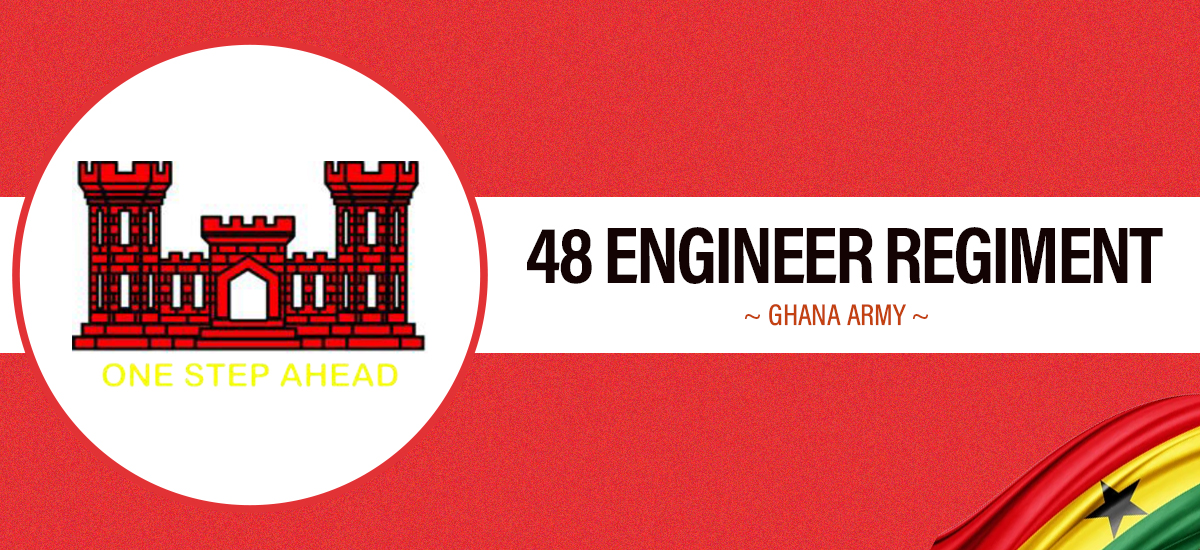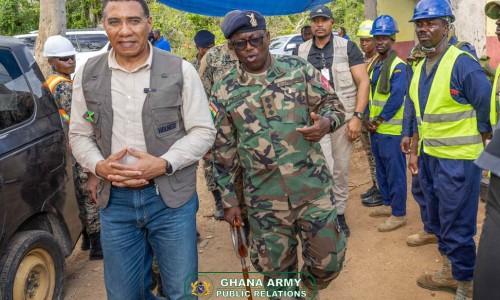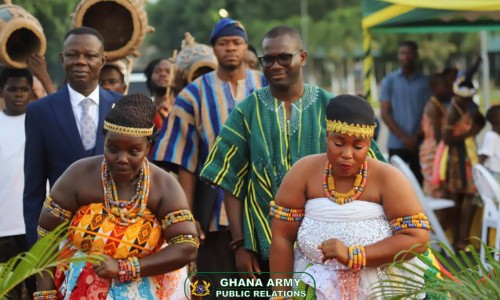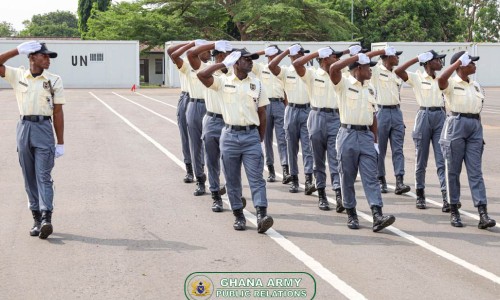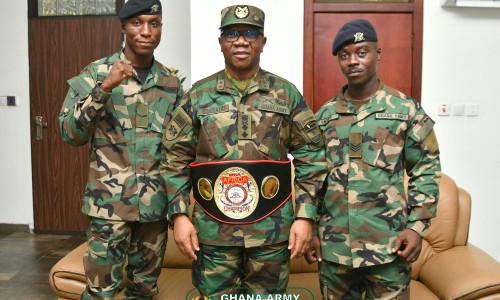BRIEF HISTORY OF THE 48 ENGINEER REGIMENT
The 48 Engineer Regiment was formed from the Field Engineer Regiment, at Teshie, probably in about February 1965. The Engineer Regiment derives its origins from the Gold Coast Field Companies which were raised in May 1943, 35/37 Field Company in May 1947.
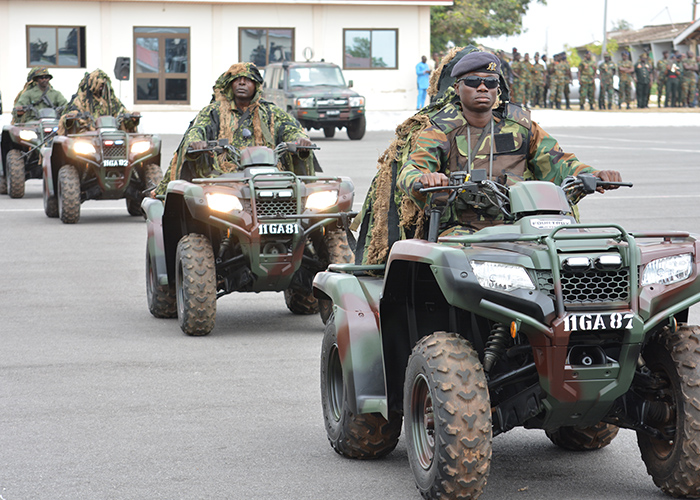
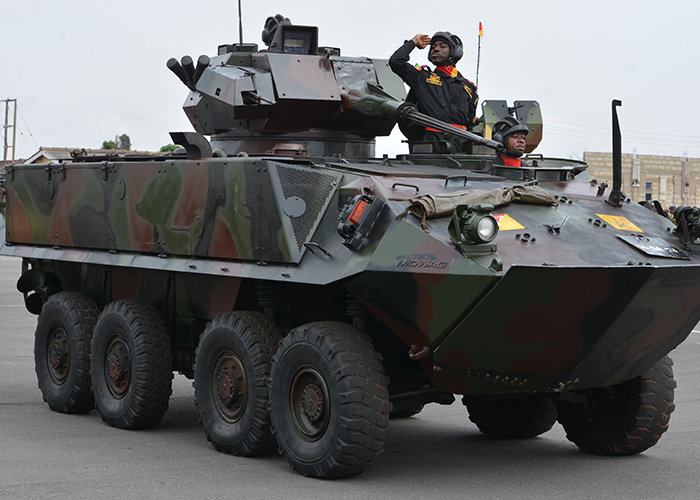
POST – WORLD WAR I HISTORY
With the expansion of the GCR of two Battalions to the four Battalions of the Gold Coast (2 WA) Brigade under Brig Gen Rose in November 1918, a Pioneer Section was also formed along with other supporting elements. Even though the Pioneer Section survived the disbandment in December 1918, it was finally under-implemented in 1922.
PRE – WORLD WAR II HISTORY
The Gold Coast Engineer Cadre (with a Survey Section) was formed as part of the European Reserve Force in 1933. In May 1939, Engineer cadre recruits from the Diamond Mines and Public Works Department were used to formed the Gold Coast Field Companies (2nd and 3rd Companies) at Akwatia and were jointly commanded by Majs JS Thain and C Alderson. As part of the formation of 5 (WA) Brigade , 81 (WA) Division, and 2 (WA) Brigade, 82 (WA) Division, one Field Company each was formed to support the Brigades after 1942 for service in Burma. Trade Training Wings were later established at Asuansi, Kibi and Elmina in 1943 but were disbanded in 1946 after World War II.
POST – WORLD WAR II HISTORY
The 37 Field Company was formed at Teshie from elements of 2 Field Company. It was re-designated with the missing numbers 35 on 1 August 1948 during reorganisation of the RWAFF, hence the designation of 35/37 Field Company. It was subsequently re-designated 1 Independent Field Engineer Squadron (Ghana Engineers) after independence in March 1957 along with Works Services Ghana Engineers. A Construction Squadron known as the Engineer Maintenance Squadron (EMS) and a Construction Squadron (Garrison Engineers) were formed at Teshie on 1 December 1964.
They were amalgamated with the Field Park Troop and Field Squadron into the Field Engineer Regiment on 5 November 1965. The Field Engineer Regiment was established by merging the Field Park Troop and Field Squadron and Construction Squadron with Lt Col V Coker-Appiah as the first CO (3 February 1965 – 12 August 1966). A Light Aid Detachment (LAD) was formed at Teshie on 18 March 1966 while the Construction Unit was detached and formed into a separate Unit on 22 June 1966 but was disbanded on 1 March 1968 when it was placed once again under command of the Field Engineer Regiment. In March 1991, the EMS was re-designated as the 49 Engineer Regiment.
MOTTO
For both 48 and 49 Engineer Regiments, the Motto is: “One Step Ahead”. Other Engineer Slogans include “Sappers Lead the Way.”
LOCAL OPERATIONS AND ASSIGNMENTS
The 35/37 Field Company manned railway locomotives during industrial actions by the Railways Corporation in 1947-48 including repairs to tracks. It also undertood Internal Security Vulnerable Point duties during the 1948 national riots. 1 Independent Company conducted bridging and housing assistance to communities during the 1962 national floods including the construction of an airstrip. It also assisted with Akosombo Resettlement Programme in 1964 and the evacuation, rafting and clearance of the Volta Estuary. undertaken numerous similar assistance to the Civil Authority in recent times including road construction, notably in the Afram Plains and the Sefwi area in the Western Region.
EXTERNAL OPERATIONS AND MISSIONS
EMBLAZONED BATTLE HONOURS
The 2 Field Company Flag was lost during the East African Campaign. It was replaced in the Arakan with a Burmese Paddle which Maj RT Blayney used as walking stick. The Stick is now in the Military Museum. The 48 Engineer Regiment was presented with Regimental and National Colours in 1994 by HE JJ Rawlings.
ACCREDITED BATTLE HONOURS AND AWARDS
Two Military Crosses (MCs) were awarded to officers during World War II in East Africa (1940-41): 2/Lt Ballenden, 2 Field Company during the Battle of Wajir, and Lt Walker, 3 Field Company during the Battle of Alghe. Two GMs were awarded to Col V Coker-Appiah during the 1966 coup and Lt Gen WM Mensah-Wood during the Armed Forces Revolution (1979/1981).


